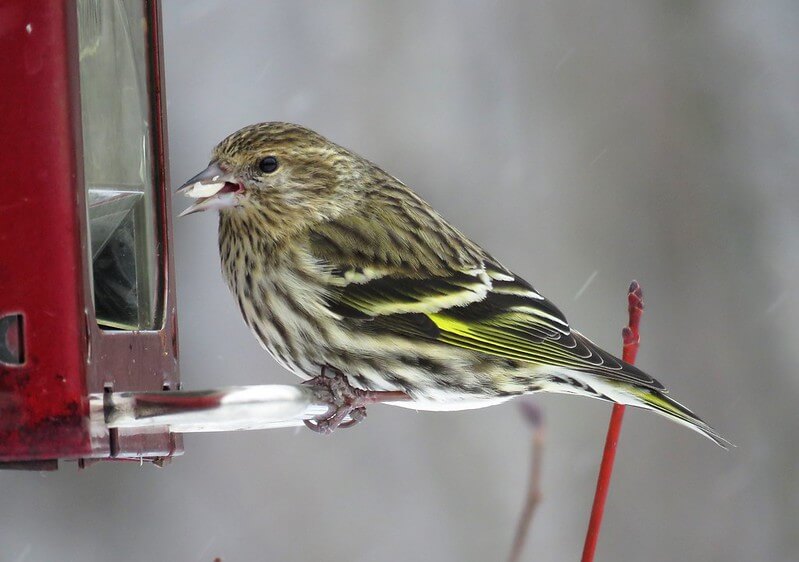Boom Or Bust: Boreal Forests, Irruption And Pine Siskins
by Elizabeth Domenech
Broadcast 3.16 & 3.19.2021

“…a quick, nervous, dark, drab, ultra-squeaky pipsqueak of a bird that makes up in sass and belligerence what it lacks in size.” Photo by Alex Galt/USFWS (CC 2.0).
Listen:
I often feel that new words come to me at the exact right moment. This fall, I had one of those moments of synchronicity, when I began to see the word “irruption” in various places – a word that until then was unfamiliar to me.
(Rather than “eruption” like a volcano, “irruption” is spelled with an i and two rs.) Typically used in conjunction with the word “event,” an irruption event describes birds that move southward when there is a shortage of food in their home range.
Aha! Perhaps this word had arrived in my life precisely in this moment to explain why the bird feeder hanging from the green ash tree outside my living room window had suddenly become a haven for Pine Siskins. If you haven’t seen one before, a Pine Siskin looks somewhat like a finch, somewhat like a sparrow, but much smaller. Their beaks are more slender than a finch’s or sparrow’s, and their tails are heavily notched in a V-shape. Their breast is distinctively striped, and they have yellow markings on the wing and tail feathers. Pete Dunne, in his Essential Field Guide Companion, calls them “a quick, nervous, dark, drab, ultra-squeaky pipsqueak of a bird that makes up in sass and belligerence what it lacks in size,” but more on that later.
Why were all of these Pine Siskins suddenly at my feeder, normally host to an array of House Sparrows, dreaded European Starlings, and an occasional Northern Flicker or Downy Woodpecker? It turns out that along with everything else it was, 2020 was an irruption year. Canada’s boreal forests produced fewer conifer seeds than usual, driving the birds that rely on those seeds further south in search of food. Specifically, the pines, spruces, and hemlocks that birds in the finch family (like the Pine Siskin) rely on produced fewer cones and seeds.
As with agricultural crops, tree cone crops can follow a boom and bust cycle of production. If a cone crop failure occurs in the year after a particularly abundant year, bird populations may be higher (having risen in the good year). Higher bird populations would then increase pressure on scarce food sources in the irruption year, driving flocks southward in search of food. The larger the geographic area and the more tree species impacted, the more bird species you’ll see moving out of their typical winter range.
In Montana, we’re particularly likely to see birds affected by an irruption year, since in bird miles we’re not far from the Canadian boreal forests. In 2020, however, people as far south as Bermuda and as far west as Portland saw Pine Siskins, Purple Finches, Evening Grosbeaks, Red-breasted Nuthatches and Common Redpolls – all birds you are likely to find in an irruption year. 2020 turned out to be one of the biggest irruption years ever recorded for Pine Siskins. Normally strictly diurnal, or daytime, migrants, Pine Siskins were even recorded migrating at night this year, for the first time in over a decade. According to the Finch Research Network, it seems the severity of the food shortage caused Pine Siskins to temporarily adopt migration patterns more typical of other songbirds.
Back to Pete Dunne: his Field Guide tells us that Pine Siskins are known to be fairly fearless, “constantly challenging occupants for their perches or standing [their] ground against larger birds….[W]hen feeding flocks are flushed, Pine Siskin is usually the last bird out and first one back.” This year in particular, Pine Siskins were seen displacing local resident birds at feeders like my own, due to the sheer size of the siskin flocks.
While I welcome the extra activity at my feeder, and particularly appreciate the Red-breasted Nuthatches that add color and whimsical movement to the otherwise drab winter-scape, I can’t help but wonder how climate change affects irruption. Will we start seeing irruption events more frequently, if boreal food sources dwindle? If so, what will happen to local bird populations over the long term if irrupting birds like Pine Siskins drive them away from feeders in droves? What will the makeup of my feeder look like next fall, or fall 20 years from now? I don’t know these answers, but I’m certainly inspired to keep paying attention.
Every week since 1991, Field Notes has inquired about Montana’s natural history. Field Notes are written by naturalists, students, and listeners about the puzzle-tree bark, eagle talons, woolly aphids, and giant puffballs of Western, Central and Southwestern Montana and aired weekly on Montana Public Radio.
Click here to read and listen to more Field Notes. Field Notes is available as a podcast! Subscribe on iTunes, Google Play, or wherever you listen to podcasts.
Interested in writing a Field Note? Contact Allison De Jong, Field Notes editor, at adejong [at] montananaturalist [dot] org or 406.327.0405.
Want to learn more about our programs as well as fun natural history facts and seasonal phenology? Sign up for our e-newsletter! You can also become a member and get discounts on our programs as well as free reciprocal admission to 300+ science centers in North America!












